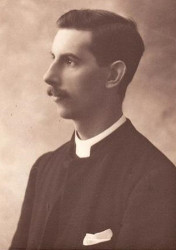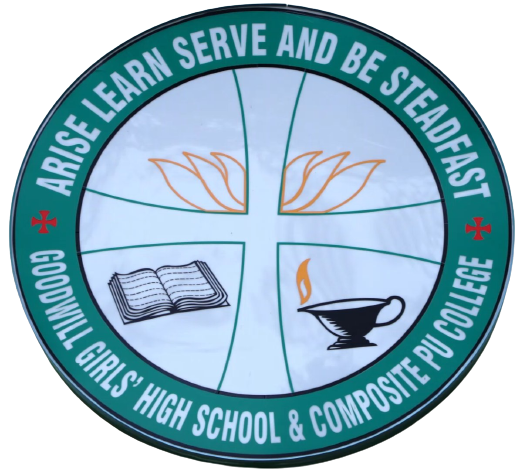
Rev. Fred Goodwill
HISTORY OF GOODWILL INSTITUTIONS
Education in British India was male oriented and educating a girl child was considered as a taboo by both the Hindus as well as the Indians Christians. Communities which were considered as lower castes had no access to education. Into a society with such traditions emerged the lady missionaries with the solid purpose of educating women in the latter part of nineteenth century. Goodwills was an offspring of that noble movement. The Methodist missionary society can certainly claim to have been pioneers in the matter of girls’ education in this town.
Goodwill Girls’ High School had its genesis in the vision of Mrs little who quite contrary to her name had a great foresight for the education of girl child in this part of Bangalore city with feeble resources and limitations, but with an iron will took up the challenge and established the Mrs Little’s native girls’ school with 36 children on 2nd September 1855 at the East Parade (present Manipal Centre on Dickenson Road).
The school was mainly started for educating children of native sepoys of the Madras Presidency Army who were stationed at the Bangalore Civil and Military Station.
After the departure of Mrs Little from the School, a teacher from England was specially appointed for the work in 1859. It was stated that the aim of the school was to impart useful knowledge to the girls in their own language and thus fit them for the sphere in which they are likely to move. The school is not only an educational agency but a means of training young women in the knowledge and fear of God.
The syllabus was framed to cater to the girls’ requirement. The subjects taught were Tamil, History, Geography, English and Scripture. They were also taught sewing and crochet. The teaching of sewing to the girls and instruction in making in their own garments began at an early date, but we see that the irregular attendance at the school hindered progress, a problem not unknown even today. In 1880 a sale of work realised Rs 30 and was pronounced ‘very successful.
In 1886 the first Prize Distribution of the school took place at the Mayo Hall. By this time prominence had been given to the study of English, and the middle school examination was conducted in English in all subjects. 1888 was an important year, for the school moved it’s premises to the present site a sprawling 14 acres of land which was purchased in 1821 by the Wesleyan Tamil mission for its use. Those in charge at that time reported ‘We have secured perhaps the best situation that could possibly be obtained for a school of this character, and we have erected a building which is sufficiently commodious to allow for any reasonable increase of numbers for several years. The successors of the planners and builders of those days have had great cause for thankfulness in the excellence of that site chosen.
Service to the community has been the primary aim of this school throughout its history and so it is not surprising that from the thousands who have passed through its classes, doctors, nurses, health visitors, teachers and in these days industrial and corporate workers have been sent out into all parts of the world. During the years of the war, our students were in service in the ANS, WAACWR, INS the Red Cross and other services from Siam (Thailand) and Burma to Palestine and Egypt and all over India.
Soon after the school’s foundation the boarding home was started which has continued to be one of the most important features of the work up to the present time. Here the girls have the opportunity to follow the highest ideals of conduct, services and here was the training ground for character and useful practical activity. In 1907 when Miss Sisterson was in charge of the school we read “girls are not perfect but they have ideals of perfections and are striving towards them. Work has been like a voice saying; - The best is yet to be, patience, the end is not yet.”
When the school was raised to a High School in 1814, it was the first one for girls in the station and even though many more high schools within the vicinity, yet we flourished. In 1919 and again in 1934 new buildings were added and these included the new class rooms, the office, the auditorium, two science laboratories and the art room.
One of the aims of the school has been to impart training to young women who are aspiring to become academicians. As early as 1875, two old students of the boarding home were Head Mistress of schools in the town, a very advanced position for women in those days. Since then the Alumnae of Goodwill’s have occupied the higher echelons in all walks of life.
Though the school enshrines the names of many superintendents to none is so great a debt owing, as to Miss Sisterson who with lavish devotion and untiring service gave the best years of her life to the school. She took charge of the school in 1906. Under her guidance and largely through her efforts the school was raised to a high school in 1914. Few schools could have the privilege of more than 32 years of devoted service such as what Miss Rose Sisterson gave. Her amazing energy, interest in every individual girl and teacher, her strictness and yet unfailing kindness have remained vividly in the minds of all who knew her.
For many years Miss Sisterson’s right hand was Rev Fred Goodwill, who was the manager of the school, He was also a Tamil scholar and contributed immensely to the education and progress of Tamil literature in Bangalore’s cantonment. He authored many academic articles on Tamil literature, mainly on Shaivism and were published in journals. His wife Mrs Alice Goodwill too took a great active part in educating the children and for sometime taught needle work too. Rev Goodwill has founded a prize for the student who gains the highest mark in Tamil in the SSLC examination. And in honour of his work at the Wesleyan Girls’ Tamil School was renamed as Goodwill Girls’ School in 1924. He once wrote in ‘preparing girls for future work we remember that time when foreign missionaries will be a thing of the past.
The school also owes a great deal to Miss R E Roper who worked here from1920 to 1949. We are indebted to her for the beautiful school garden and for most of the trees which surround the compound. Her own great love of nature was passed on to many students. She was pioneer on Guiding in Mysore State and the companies of Guides and two Bulbul flocks which exists today were initiated by her at a time when Guiding was in its infancy in this area. She was also instrumental in opening the school hostel. She planned it and laid down the foundation of home training and Christian living which became its characteristics.
The School celebrated its centenary in the year 1955 and the teachers’ hostel was built in its commemoration. And one more record to go in the history of the Institution is the inception of the Primary section in 1975. During the 125th year quasquicentennial anniversary to mark its celebration an auditorium was built. And in the year 1987 staff rooms and the Chapel on the first floor was constructed.
The CSI Goodwill Polytechnic was started in the year 1992, offering Diploma courses in the Computer Science and Technology, Telecommunication and engineering and Secretarial Practice.
A proper well equipped library was in great need for the school. So for the 140th year celebration in 1995 the old library was renovated and was called the ‘Little’s Library’ named after Mrs Little the founder of our school. It’s a pity her name has remained forgotten in the history of the school and not even a photograph of her is available. The library has been a great blessing in promoting the habit of reading which is dying out with the modern technology and gadgets.
During the tenure of Mrs Bimla Phillips the year 1996 once again went down in the annals of the Goodwillian history, as the institution has been elevated to the Pre University. The courses in the Pre University catered to the main three streams of Science, Commerce and Arts subjects. To start with the PUC block 3 large renovated class rooms, equipped with 50 dual desks, a lecture hall, Science laboratories and another laboratory. A new block had been constructed this year which included the labs for Physics, Chemistry, Biology and Computer Science.
In the year 1998 a resident teachers block which was named as ’Beth Shalom’ House of Peace, was built in the student hostel campus. A Canteen one of the long felt needs of the staff and students was built adjacent to the polytechnic and named ‘Bethcar’ meaning House of Light in 1999. Under the leadership of Miss Mohanakanthi Samson in the year 2000 the Institution once again was elevated to a Degree College.
In the year 2005, under the leader ship of Miss Rathnanjali Nicodemus the institution had it’s the sesquicentennial (150th year) celebrations and to commemorate this new Pre University class rooms ‘ Beth Hamidrash’ House of Learning were added and also a new Library, Audio Visual Room and Computer Lab were built.
The ‘Christmas Nativity’ which takes place every year has become the tradition of the Institution. The Institution has been managed by the Church of South India, Karnataka Central Diocese with the Bishop as its Chairman.
The School has changed and developed tremendously according to times, providing the environment for girls to weave all round qualities for development.
We place on record the selfless service rendered by other former Principals who strived hard to bring up the Institution to the present status. Miss Winifred Rogerson (1940 – 1960), Sis. Padma Krishnappa (1955 -1959), Miss Azilla Adiappa (1960 – 1970), Miss Jyothi Parker (1970 -1991), Miss Bimla Phillips (1991 -1995), Miss Mohanakanthi Samson (1995 – 2000), Miss Rathnanjali Nicodemus (2001 – 2005), Mrs Jameela Paul (2005 - 2009), Mrs Vani Mohan (2008 – 2016), Mrs Evangeline Jeyakumari (2017 – 2019), Mrs Gnanamoni Franklin (2019 -).
The Institution has been standing tall for 168 glorious years with a rich heritage to be proud of our predecessors who were magnanimous with their patience, loyalty, devotion and sought to provide the best in the sphere of girls’ education. The Original stone structure built in 1888 still stands as a prominent land mark. The Institution continues to instil Christian values along with academics to under privileged students.
The work of our Predecessors has inspired generations of educators at our Institution to aspire and prepare our students to greater heights of excellence and also to meet challenges ahead holding on to our school motto Eluka, Karka, Paniceya nirka (ARISE, LEARN, SERVE AND BE STEADFAST).
